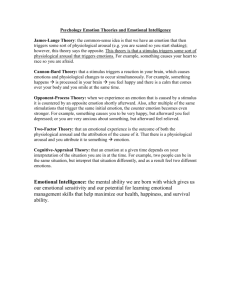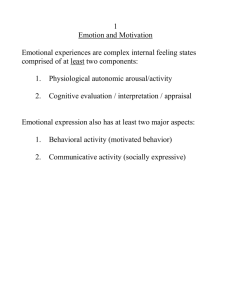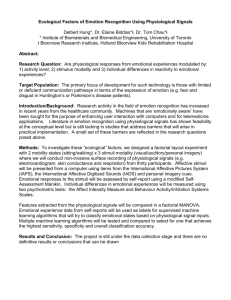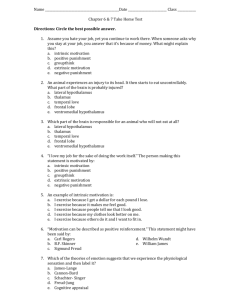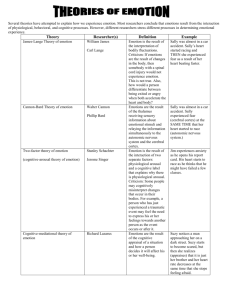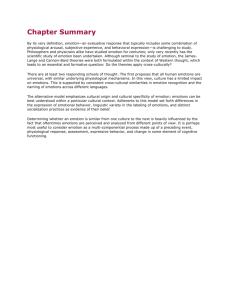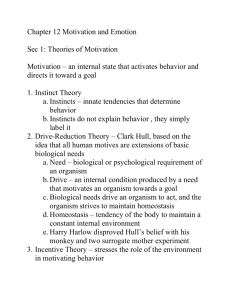Chapter 10 Suggested Answers Review 10.1 1 Plutchik's eight
advertisement
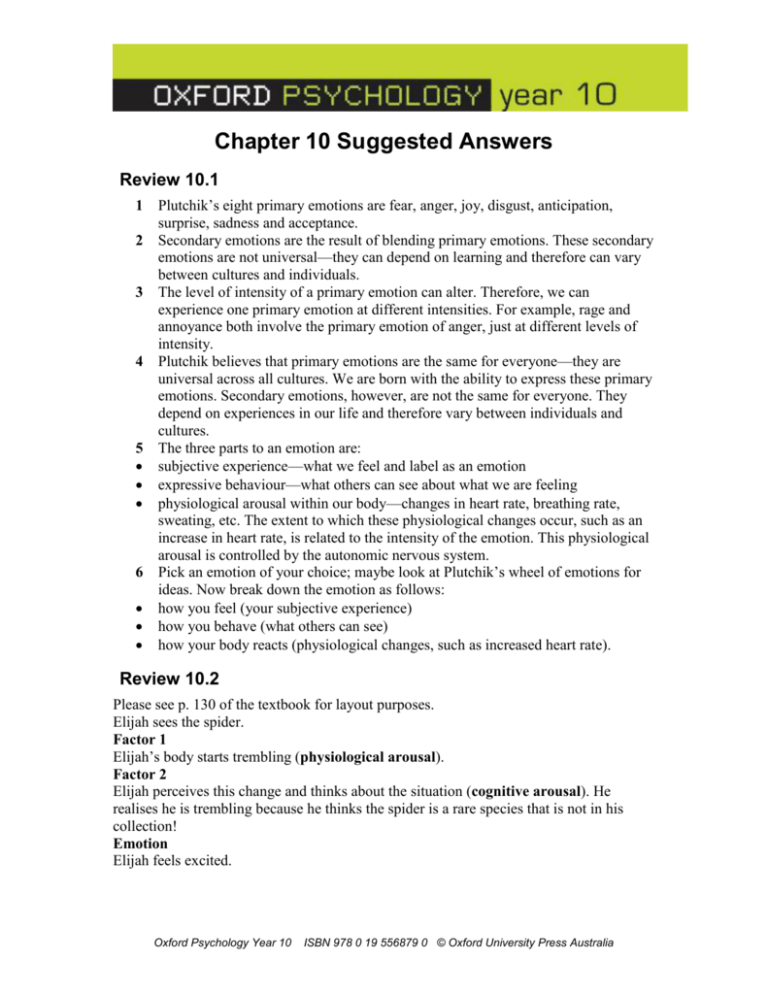
Chapter 10 Suggested Answers Review 10.1 1 2 3 4 5 6 Plutchik’s eight primary emotions are fear, anger, joy, disgust, anticipation, surprise, sadness and acceptance. Secondary emotions are the result of blending primary emotions. These secondary emotions are not universal—they can depend on learning and therefore can vary between cultures and individuals. The level of intensity of a primary emotion can alter. Therefore, we can experience one primary emotion at different intensities. For example, rage and annoyance both involve the primary emotion of anger, just at different levels of intensity. Plutchik believes that primary emotions are the same for everyone—they are universal across all cultures. We are born with the ability to express these primary emotions. Secondary emotions, however, are not the same for everyone. They depend on experiences in our life and therefore vary between individuals and cultures. The three parts to an emotion are: subjective experience—what we feel and label as an emotion expressive behaviour—what others can see about what we are feeling physiological arousal within our body—changes in heart rate, breathing rate, sweating, etc. The extent to which these physiological changes occur, such as an increase in heart rate, is related to the intensity of the emotion. This physiological arousal is controlled by the autonomic nervous system. Pick an emotion of your choice; maybe look at Plutchik’s wheel of emotions for ideas. Now break down the emotion as follows: how you feel (your subjective experience) how you behave (what others can see) how your body reacts (physiological changes, such as increased heart rate). Review 10.2 Please see p. 130 of the textbook for layout purposes. Elijah sees the spider. Factor 1 Elijah’s body starts trembling (physiological arousal). Factor 2 Elijah perceives this change and thinks about the situation (cognitive arousal). He realises he is trembling because he thinks the spider is a rare species that is not in his collection! Emotion Elijah feels excited. Oxford Psychology Year 10 ISBN 978 0 19 556879 0 © Oxford University Press Australia Review 10.3 1 2 3 4 5 6 7 The James-Lange theory proposes that physiological arousal occurs before feeling the emotion. Bodily changes lead to the emotional experience; in other words, the physiological changes cause the subjective feeling. The facial feedback hypothesis predicts that changes in our facial expressions can produce emotional experiences to match these changes. In other words, smiling will make us happier, while frowning will make us sadder, and so on. The physiological changes will cause the subjective feeling and this hypothesis therefore supports the James-Lange theory of emotion. The Cannon-Bard theory states that once we become aware of the event, this information triggers both physiological arousal (trembling) and the subjective experience (fear) at the same time. The Cannon-Bard theory states that physiological changes occur at the same time as feeling the emotion (subjective experience). The facial feedback hypothesis states that physiological changes (facial expression) occur before experiencing the feeling. Cognitive appraisal relates to thinking about the situation and deciding what it means. How we appraise a situation (cognitive appraisal) and the reasons for physiological changes in our body (physiological arousal) leads to our emotional feeling (subjective experience). Think of a situation, such as waiting in line at the canteen. Now think of two different ways you can ‘appraise’ or think about this situation. State how each thought can lead to a different emotion. Review 10.4 1 2 3 4 An indifference reaction is when a person is quite unmoved or unemotional about a serious event. The person carries on as if it did not occur. This may occur when there is damage to the right motor area of the brain. A catastrophic reaction is when a person has a severely negative emotional response to a situation. This may occur when there is damage to the left motor area of the brain. The hypothalamus plays a central role in experiencing emotions. The hypothalamus converts emotional messages from the cortex into autonomic and endocrine responses. This means it controls physiological arousal and hormonal reactions. The hypothalamus plays a role in causing or preventing aggressive behaviour. A number of emotions but mainly strong emotions, such as fear. Test your understanding 1 2 A B Oxford Psychology Year 10 ISBN 978 0 19 556879 0 © Oxford University Press Australia 3 4 5 6 7 8 9 D C D B The three components of an emotion are: • subjective experience—what we feel and label as an emotion • expressive behaviour—what others can see about what we are feeling • physiological arousal within our body—changes in heart rate, breathing rate, sweating and so on. Both theories consider physiological arousal and subjective feelings. Both ignore what a person is thinking and how the person interprets the event (cognitive appraisal). According to the James-Lange theory of emotion, physiological arousal occurs before our subjective feelings. This is different from the CannonBard theory, which proposed that physiological arousal and subjective experience occur at the same time. The facial feedback hypothesis predicts that changes in our facial expressions can produce emotional experiences to match these changes. In other words, smiling will make us happier, while frowning will make us sadder, and so on. The physiological changes will cause the subjective feeling and this hypothesis therefore supports the James-Lange theory of emotion. 10 Interviewed on a solid bridge (low arousal group) Factor 1 Few physiological changes (physiological arousal) Factor 2 Person thinks about the situation (cognitive appraisal) but with little physiological changes does not take much notice of the survey or the experimenter Emotion Does not feel a strong emotion (and therefore does not contact the experimenter after the interview) Interviewed on a solid bridge (high arousal group) Factor 1 Strong physiological changes (physiological arousal) Factor 2 Person thinks about the situation (cognitive appraisal) and notes that the physiological changes are due to the attractive experimenter Emotion Does feel a strong emotion of attraction (and therefore contacts the experimenter after the interview) 11 Primary emotions are ones we are born with and are universal across all cultures; that is, the same for everyone. Other emotions are a combination or mixing of the Oxford Psychology Year 10 ISBN 978 0 19 556879 0 © Oxford University Press Australia 12 13 14 15 primary emotions and are ones we learn and they are therefore different between individuals and cultures; that is, not the same for everyone. a Sara went for a 5 km run. Factor 1 Sara experiences strong physiological changes—increased heart rate and breathing rate (physiological arousal). Factor 2 Sara thinks about the situation (cognitive appraisal) and notes that the physiological changes are due to going for a run. Emotion Sara feels a strong emotion because she does not think the physiological changes are due to an emotional event. b According to the James-Lange theory of emotion, physiological arousal occurs before our subjective feelings. However, Sara does not experience an emotion even though she experiences physiological arousal. The James-Lange theory does not include cognitive appraisal. It does not account for the fact that not all physiological arousal leads to an emotion. Our expectations can lead us to think (appraise) in line with these expectations. If we expect to like a television show, when we see the show we are more likely to decide (appraise) that we like it and therefore enjoy it (emotional experience). a Right side b A catastrophic reaction. Note: This does not mean that a catastrophic reaction will definitely occur. a Saying ee makes us ‘smile’ and this change leads to happy feelings. Saying oo causes us to put on a sad face and this change makes us sad. b The facial feedback hypothesis supports the James-Lange theory of emotion. c You may like to test this on yourself first. You could use a procedure similar to the one in Investigate 10.3 (p. 129) in the text. Oxford Psychology Year 10 ISBN 978 0 19 556879 0 © Oxford University Press Australia
